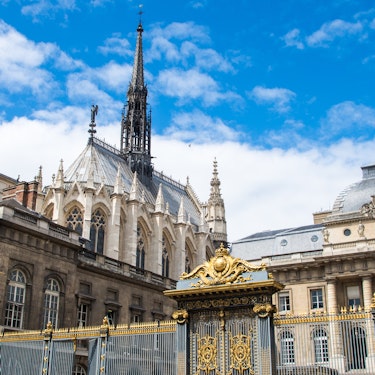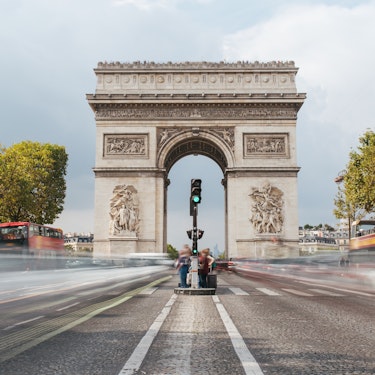More about: 10 Things You Can't Miss at the Gardens of Versailles
The gardens of the Palace of Versailles are almost as iconic as the palace itself. A masterpiece of French landscaping and a joy to behold, they combine nature and art in perfect harmony.
After seeing the rooms and luxury of the Palace of Versailles, the next stop on your tour of the complex is its famous gardens filled with lakes, fountains, flowerbeds and flowers.
If the architecture and ornamentation of the palace itself has left you in awe, the gardens are no less so. This is what you can see in the gardens of Versailles- read on!
1. The parterres
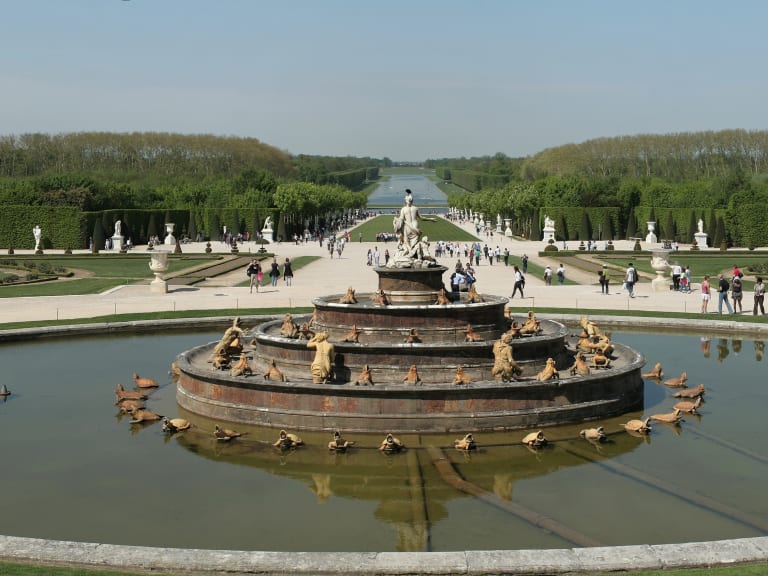
During your visit to the gardens of the Palace of Versailles, you will see several water parterres reflecting the imposing façade of the building.
Water Parterre
This was designed to reflect the sunlight on the water to illuminate the outer wall of the famous Hall of Mirrors.
It is divided into two pools decorated with sculptures of nymphs and children representing the great rivers of France.
From here you will have an amazing view of the groves, gardens, fountains and paths leading to the Grand Canal.
North and South Parterre
Both parterres can be seen from the Water Parterre and border the base of the Palace of Versailles.
Inside the North Parterre you can see the bronze statues of Venus and The Windmill as well as a large pond adorned with the Pyramid Fountain.
The South Parterre is known as the flower garden and has spectacular views of the Orangery from its balustrade. Take a look, because from here you will be able to take some of the most beautiful photographs of your visit to the Palace of Versailles Gardens.
Latona Parterre
Located in the heart of the Versailles Gardens, the Parterre de Latona and its fountain is one of the most striking and beautiful in the complex.
It was inspired by Ovid's Metamorphoses and tells the myth of the goddess Latona, mother of the gods Diana and Apollo, who asked Jupiter for help to take revenge on the peasants of Lycia whom she turned into lizards and frogs.
2. The Orangery

The Orangerie is a beautiful orangery below the South Parterre which, being sheltered from the cold winds, is a fantastic place to grow citrus fruit trees and other species such as olive trees, oleanders, palms and pomegranate trees.
Many of these trees are over 200 years old and came from southern European countries such as Spain, Portugal and Italy. King Louis XIV loved to show off the trees of the Orangerie to his guests. Versailles even had the largest collection of orange trees in Europe.
Today, many of these plants are planted in pots which are taken out of the Orangery to be displayed in the flowerbeds from the arrival of spring onwards, and when winter sets in, they are returned to the interior of the building.
3. The fountains
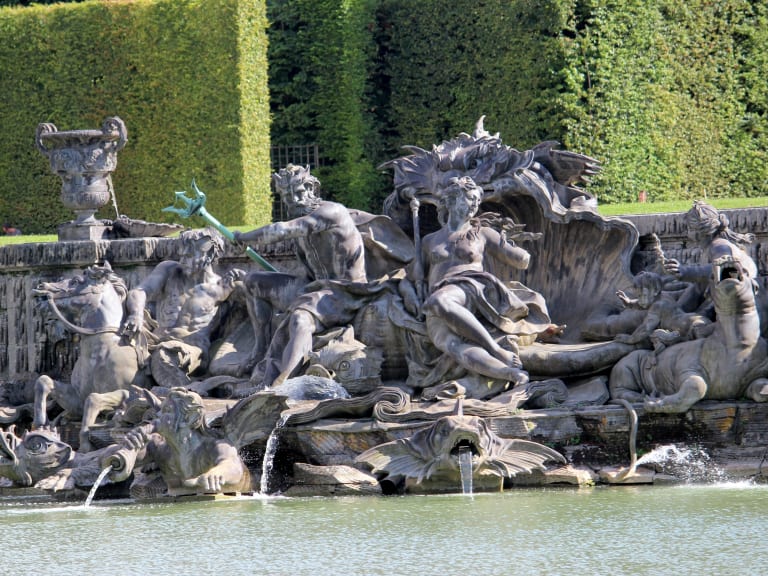
The fountains of Versailles are one of the greatest spectacles you will see during your visit, along with the gardens themselves.
They are scattered throughout the complex and there are more than fifty fountains whose design was inspired by themes from classical mythology.
Some of the most impressive ones you will see during your tour of the gardens of Versailles are the Fountain of Neptune, the Fountain of Latona, the Fountain of Apollo, the Fountain of the Animal Fight or the Fountain of the Dragon.
When can you see the exhibition of the Great Musical Waters in the fountains of Versailles?
Every year the fountains of Versailles are restored to the splendour they had centuries ago in the time of King Louis XIV when they are put into operation between the end of May and the end of October to delight tourists with a wonderful spectacle of music and water called the Great Musical Waters.
There are daytime and night-time displays at the fountains of Versailles, although the latter only take place in summer, from mid-June to mid-September, when the weather is fine.
In addition, every Saturday in summer, the Great Musical Waters show at night is joined by fireworks, making the experience even more special and breathtaking. If you have the chance to see it, I highly recommend it.
What are the opening hours of the show at the Versailles fountains?
- Great Musical Waters: Saturdays and Sundays from 22 May to 31 October and some public holidays such as the French National Day (14 July).
- Great Musical Waters at Night: Saturdays from 12 June to 18 September and public holidays such as the French National Day (14 July).
How much does admission cost?
Although access to the gardens of Versailles is generally free, if you want to visit the fountains during the period when the Great Musical Waters show is on, you will have to pay an entrance fee.
Prices start at €9.50 for general admission and €8.50 for reduced admission. Children from 0 to 5 years old can enter free of charge.
4. The groves

As you stroll through the gardens of the Palace of Versailles you will be surprised to see so many groves of trees and during the reign of Louis XIV there were no less than fifteen, which were adorned with statues, vases and fountains.
The groves at Versailles were like open-air salons where the monarchs used to stroll and entertain at lunches, dinners, balls and other social events.
Today you can visit several of these groves such as the Queen's Grove, the Ballroom Grove, the Girandole Grove or the Enceladus Grove.
5. The sculptures

For Louis XIV, the gardens of Versailles were not only a place to stroll, relax and enjoy nature, but also a symbol of his power.
That is why he made sure that they looked majestic and adorned them with all kinds of ornaments. Countless trees, plants and flowers were planted (many of them exotic for the time) and numerous fountains and sculptures were installed and designed to enhance his glory.
The theme of many of these sculptures revolved around gallantry and love (Eros), around the god Apollo as a metaphor for the king's own power and, as his reign progressed, also around childhood. That is why in the gardens you can see many statues of children playing with dolphins and tritons.
With over 300 sculptures scattered throughout the gardens, this is the largest open-air sculpture museum in the world.
6. The Walks
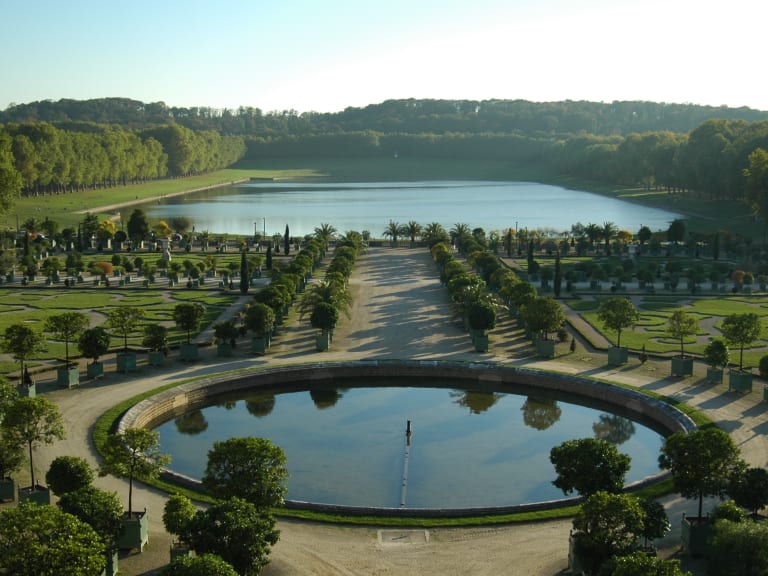
The gardens of Versailles were laid out along two axes: north-south and east-west. To help you find your way around, take a look at this map when you go on the walks route.
The Paseo del Agua is one of the most important parts of this north-south axis. It was designed in the 17th century and was adorned with fourteen fountains depicting groups of children, tritons and satyrs.
If you want to follow the north-south axis of the gardens of Versailles, it starts at the Fountain of Neptune, passes along the Promenade de l'Eau and continues to the Orangerie and the Lac de la Garde Suisse.
The east-west axis is known as the Grand Perspective. It divides the gardens of Versailles like a symmetrical axis, passes by the Fountain of Leto and continues along the Royal Route to the Grand Canal.
The Royal Route dates back to the time of King Louis XIII, although it looked completely different back then. Strolling along the Royal Way among horse chestnut, yew and hornbeam trees is a very relaxing experience before reaching the Fountain of Apollo and the Grand Canal.
7. The Grand and the Petit Trianon

If you continue walking through the gardens of Versailles you will come to the Grand and Petit Trianon, two palaces surrounded by flower gardens where monarchs liked to go to escape the hustle and bustle of the court or enjoy a few moments of relaxation.
The Grand Trianon
The Grand Trianon is a beautiful Italian-style palace built in green and pink marble that the king used for short periods of time during the summer or for furtive meetings with his mistress, the Marquise de Montespan. The building is surrounded by beautiful flower gardens.
The Petit Trianon
Located southeast of the palace complex at Versailles, the Petit Trianon is a Greek-style palace that King Louis XV ordered to be built as a gift for his favourite mistress Madame de Pompadour.
When King Louis XVI acceded to the throne, he gave it to his wife, Queen Marie-Antoinette, as a wedding gift. It also has several gardens in French and English style. In the latter is the Temple of Love, a classical-style shrine presided over by the statue of Eros.
8. The Queen's Village
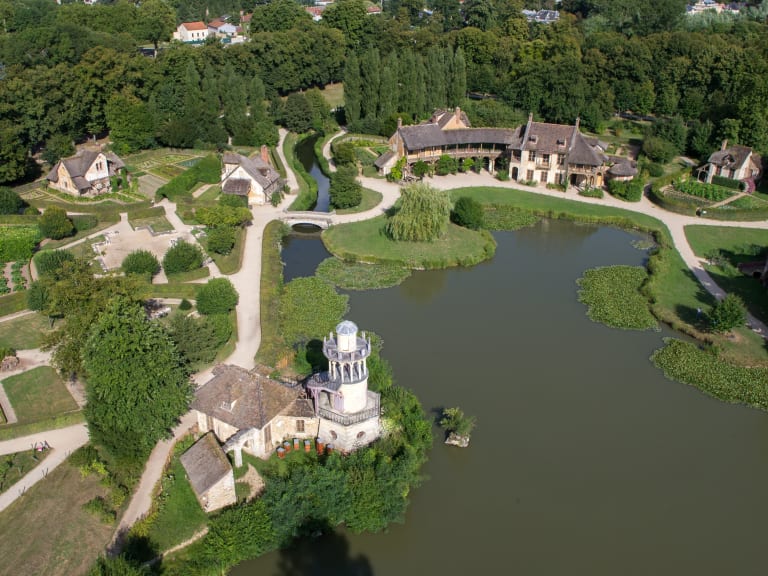
This is a small farmhouse inspired by the rustic architecture of Normandy where Queen Marie Antoinette liked to go to enjoy summer days with her children and escape the pomp of the French court.
There she enjoyed a simple country life that contrasted with the opulence of the Palace of Versailles.
The farm of the Queen's Village consisted of a mill, a dairy and several orchards that supplied the royal kitchens with produce.
9. The Park of Versailles
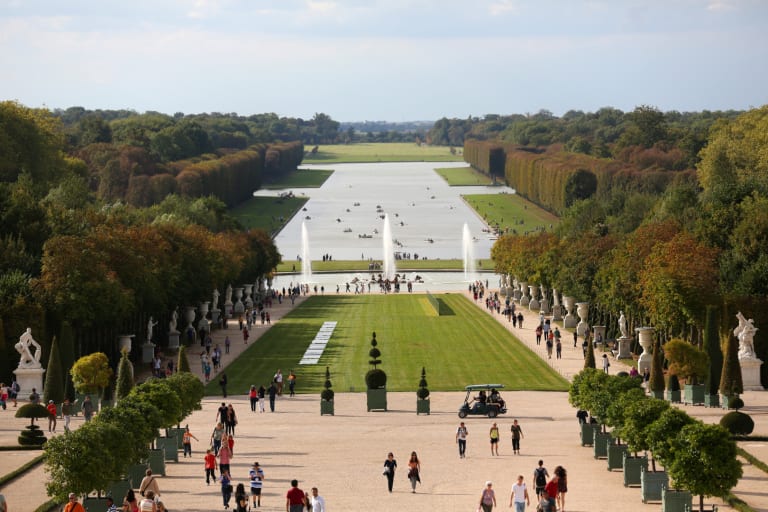
At the southern end of the Grand Canal is the Parc de Versailles, a large wooded and landscaped area which is accessible free of charge and where picnics can be organised to enjoy nature during your visit. You can bring your own food or buy it at one of the restaurants in Versailles.
You can access the Parc de Versailles by walking through the gardens (it takes about half an hour) or you can ride the tourist train at the entrance of the gardens (it will take you there in about 15 minutes).
10. The Musical Gardens of Versailles

In addition to the exhibition of the Great Musical Waters in the fountains of Versailles, the palace gardens also host another very entertaining event where music is the main protagonist: the Musical Gardens of Versailles.
During this festival, you will have the chance to contemplate the gardens of Versailles to the sound of music while you take a pleasant stroll. This is a very special experience that only takes place at certain times of the year.
When can you attend the Versailles Musical Gardens show?
Every year, during the summer and autumn season, this musical concert takes place in the heart of the Versailles countryside.
What are the opening times for the show at the Versailles fountains?
-
From the beginning of July to the end of August: Tuesdays, Wednesdays, Thursdays and Fridays.
-
From the beginning of September to the end of October: Tuesdays, Thursdays and Fridays.
What is the ticket price?
Although the gardens of Versailles are normally free of charge, if you want to attend the Musical Gardens of Versailles show you will have to pay a ticket.
The general admission price for this event is from €8.50 and the reduced admission is from €7.50. Children from 0 to 5 years old can enter for free.
When are the Gardens of Versailles open?

The Gardens of Versailles are open daily from 8 AM to 8:30 PM.
How much does it cost to enter the Gardens of Versailles?
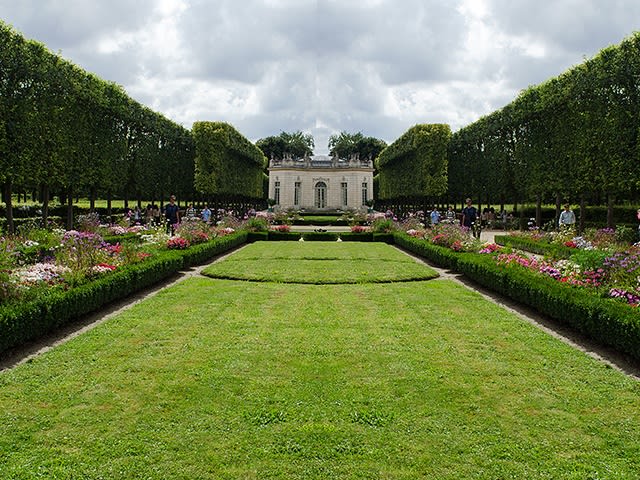
Access to the gardens is free except on the days of the Grand Eaux Musicales where you can buy a general admission ticket from 9,50 € and a reduced ticket from 8 €. Children from 0 to 5 years old are free.
If I only want to visit the Gardens of Versailles, do I have to wait in the general admission queue?
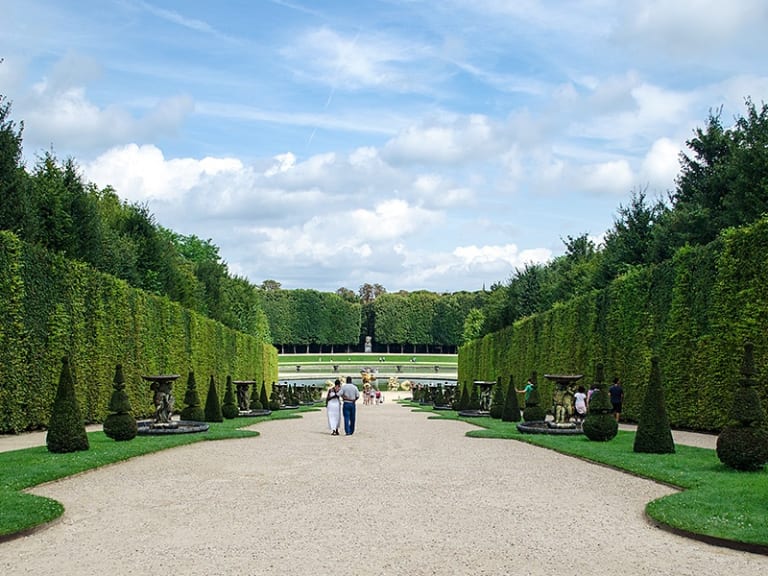
No, you do not need to queue to visit the Gardens of Versailles only. You can enter them directly from the Queen's Gate or from the left side of the Palace.
Tips for visiting the gardens of Versailles
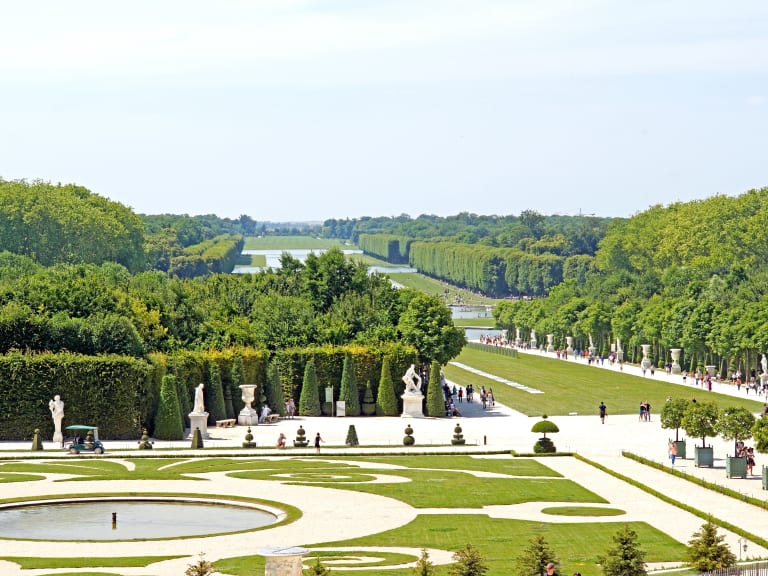
- Before making the trip to the Palace of Versailles, check the weather forecast for the day of your visit. If heavy rain or strong winds are forecast, it is likely that the gardens will be closed to the public.
- The gardens of Versailles cover an area of 800 hectares- they are immense! If you are going to spend several days in Paris, for example between 4 days and a week, I advise you to dedicate a full day to Versailles to visit it at your leisure. Rushing is not good, especially if you are going to Versailles with children who need to take it easy.
- Between the visit to the Palace of Versailles and its gardens, lunchtime will probably catch you in the middle of the tour and you'll have to stay there for lunch. Don't worry, there are plenty of fantastic places where you can take a break and recover your energy. In the post Where to eat in Versailles I tell you about several options.
- Don't carry too much weight in your bag for your visit. Take only the essentials because walking around the gardens of Versailles for hours carrying weight will leave you with a sore shoulder. Also, the entrance is very strict about what you can bring into the Palace of Versailles and its gardens, so don't take too much stuff. You can also use the left-luggage office, which is free of charge.
- You can visit the gardens of Versailles first before seeing the palace. In that case, when you arrive, enter the main esplanade and on the left side you can enter the gardens through the princess's garden. However, in my opinion, it is better to do it the other way round.
- Download the app of the Palace of Versailles and its gardens to make the visit. It is available on both Android and iOS. As well as an audio guide to the Domaine de Versailles, it also has a geo-locatable map to help you with your route.





